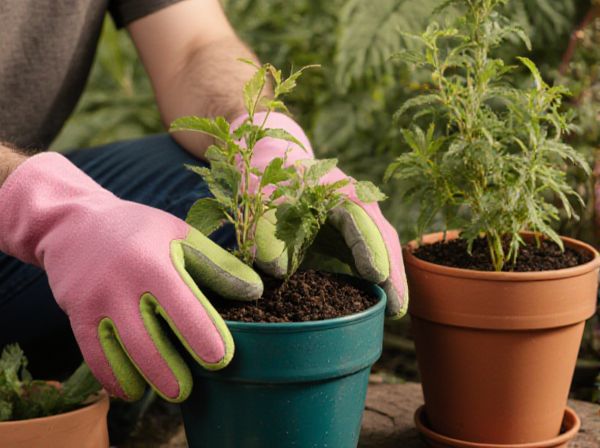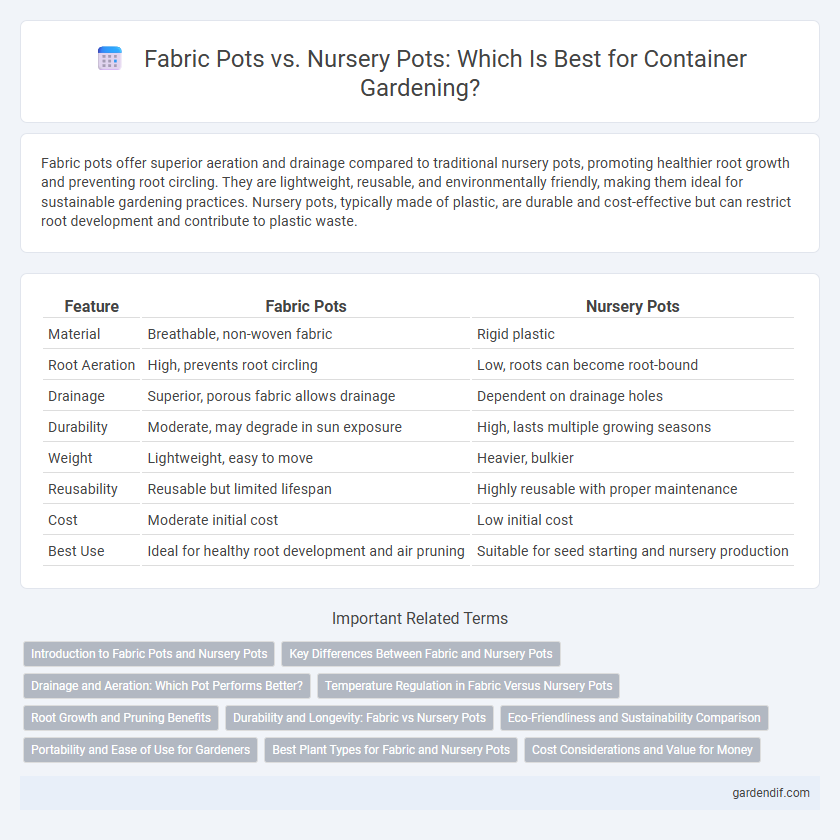
Fabric pots vs nursery pots Illustration
Fabric pots offer superior aeration and drainage compared to traditional nursery pots, promoting healthier root growth and preventing root circling. They are lightweight, reusable, and environmentally friendly, making them ideal for sustainable gardening practices. Nursery pots, typically made of plastic, are durable and cost-effective but can restrict root development and contribute to plastic waste.
Table of Comparison
| Feature | Fabric Pots | Nursery Pots |
|---|---|---|
| Material | Breathable, non-woven fabric | Rigid plastic |
| Root Aeration | High, prevents root circling | Low, roots can become root-bound |
| Drainage | Superior, porous fabric allows drainage | Dependent on drainage holes |
| Durability | Moderate, may degrade in sun exposure | High, lasts multiple growing seasons |
| Weight | Lightweight, easy to move | Heavier, bulkier |
| Reusability | Reusable but limited lifespan | Highly reusable with proper maintenance |
| Cost | Moderate initial cost | Low initial cost |
| Best Use | Ideal for healthy root development and air pruning | Suitable for seed starting and nursery production |
Introduction to Fabric Pots and Nursery Pots
Fabric pots offer superior aeration and drainage compared to traditional nursery pots, promoting healthier root systems and reducing the risk of overwatering. Nursery pots, typically made of rigid plastic, provide structured support and are widely used for seedling propagation and transplanting. Both container types are essential in horticulture, with fabric pots enhancing root air pruning and nursery pots offering durability for early plant development.
Key Differences Between Fabric and Nursery Pots
Fabric pots offer superior aeration and drainage compared to traditional nursery pots, promoting healthier root growth and preventing root circling. Nursery pots, typically made of rigid plastic, provide structural stability and are often more affordable and reusable. The breathable nature of fabric pots aids in temperature regulation and reduces water retention issues common with nursery pots.
Drainage and Aeration: Which Pot Performs Better?
Fabric pots offer superior drainage and aeration compared to nursery pots due to their breathable material, which allows excess water to escape and air to reach the roots, preventing overwatering and root rot. Nursery pots, typically made from rigid plastic, have limited drainage holes that can cause water to pool and restrict airflow to the root zone. Enhanced oxygen flow in fabric pots promotes healthier root development and overall plant growth, making them a better choice for optimal drainage and aeration.
Temperature Regulation in Fabric Versus Nursery Pots
Fabric pots offer superior temperature regulation due to their breathable material, which allows excess heat to escape and air to circulate around the root zone, preventing overheating. Nursery pots, typically made from plastic, tend to retain heat, which can cause root stress and hinder plant growth during hot weather. The enhanced airflow in fabric pots also reduces the risk of root rot by maintaining a cooler, well-ventilated environment for healthy root development.
Root Growth and Pruning Benefits
Fabric pots enhance root growth by air pruning roots, preventing circling and promoting a dense fibrous root system, which improves nutrient uptake and plant health. Nursery pots often restrict root expansion, leading to root circling that can stunt growth and reduce transplant success. The breathable structure of fabric pots encourages natural root pruning, resulting in stronger, more vigorous plants compared to traditional rigid nursery containers.
Durability and Longevity: Fabric vs Nursery Pots
Fabric pots, made from breathable, flexible materials like non-woven polypropylene, offer superior aeration and root health but typically have a shorter lifespan of 2-5 years due to UV exposure and wear. Nursery pots, usually constructed from rigid plastics such as polypropylene or polyethylene, provide greater durability and can last over 10 years with proper care, resisting cracks and degradation. Choosing between fabric and nursery pots depends on balancing the benefits of enhanced root oxygenation with the need for long-term container stability.
Eco-Friendliness and Sustainability Comparison
Fabric pots, crafted from breathable, recyclable materials, significantly enhance root aeration and reduce plastic waste compared to conventional nursery pots, which are often made of non-biodegradable plastic. The reusable nature of fabric pots minimizes landfill contributions, supporting sustainable gardening practices by promoting soil health and water efficiency. In contrast, nursery pots typically have a shorter lifespan and contribute to environmental pollution, underscoring fabric pots as the eco-friendlier alternative for sustainable horticulture.
Portability and Ease of Use for Gardeners
Fabric pots offer superior portability due to their lightweight, flexible material, making them easy to move and store even when fully planted. Nursery pots, typically made of rigid plastic, provide sturdiness but can be cumbersome to handle, especially in larger sizes. Gardeners benefit from fabric pots' breathable design that facilitates root aeration while simplifying transplanting compared to the rigid structure of nursery pots.
Best Plant Types for Fabric and Nursery Pots
Fabric pots excel with plants requiring excellent aeration and drainage, such as tomatoes, peppers, and root vegetables like carrots and radishes, promoting healthier root systems and preventing waterlogging. Nursery pots are ideal for seedlings, herbs, and small houseplants that benefit from controlled moisture retention and ease of handling during early growth stages. Selecting the appropriate container type enhances plant development by aligning the pot's airflow and drainage properties with specific horticultural needs.
Cost Considerations and Value for Money
Fabric pots typically cost more upfront than traditional nursery pots but offer long-term value through improved root aeration, reduced risk of root circling, and better drainage, resulting in healthier plants. Nursery pots are less expensive initially but may require more frequent replacement due to brittleness and limited growth space, potentially increasing overall costs. Evaluating cost considerations involves balancing initial investment against durability and plant health benefits, with fabric pots often providing superior value for money in extended gardening projects.
Fabric pots vs nursery pots Infographic

 gardendif.com
gardendif.com